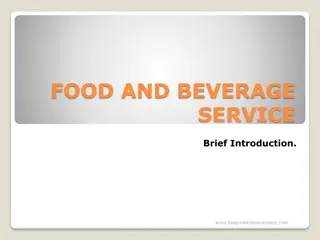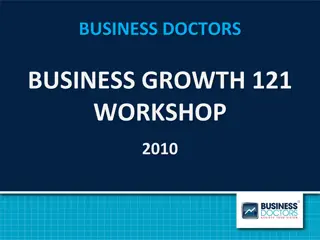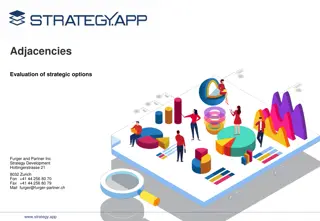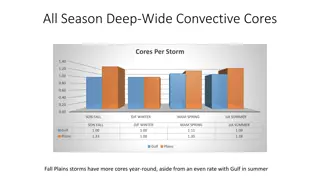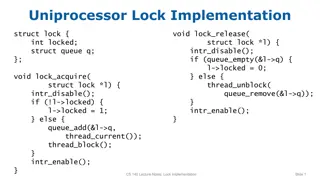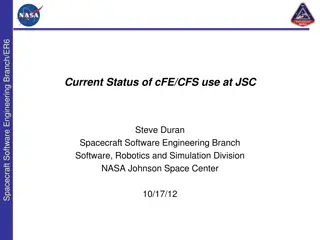Understanding Core Business Activities in a Business Setting
Exploring the concept of core business activities within an organization, this module delves into the significance of identifying and understanding specific activities such as purchasing, production, marketing, and administration. By uncovering the relationships between these core functions, businesses can enhance value and efficiency.
Download Presentation

Please find below an Image/Link to download the presentation.
The content on the website is provided AS IS for your information and personal use only. It may not be sold, licensed, or shared on other websites without obtaining consent from the author. Download presentation by click this link. If you encounter any issues during the download, it is possible that the publisher has removed the file from their server.
E N D
Presentation Transcript
BUSINESS PRACTICE LEVEL 2 TOPIC 3: MODULE 9 IDENTIFYING CORE BUSINESS ACTIVITIES
LESSON OBJECTIVES EXPLAIN THE CONCEPT OF CORE BUSINESS. DESCRIBE SPECIFIC CORE BUSINESS ACTIVITIES. DECRIBE THE RELATIONSHIP BETWEEN CORE BUSINESS ACTIVITIES. DESCRIBE WAYS IN WHICH THE CORE BUSINESS ADDS VALUE TO THE ORGANISATION.
THE CONCEPT OF CORE BUSINESS Defining the concept. A business should have a common thread running the business through all of its activities, which gives them purpose. Many businesses identify themselves with certain product or service to which most of their activities are devoted. These are the organisation s core business.
SPECIFIC CORE BUSINESS ACTIVITIES CORE BUSINESS ACTIVITIES IN THE FIRM THE SPECIFIC CORE BUSINESS ACTIVITIES COVERED ARE GENERALLY THE FOLLOWING: Purchasing (to obtain the raw material) Production or operations (where the materials are used or converted) Marketing (where the goods are introduced to the customer) Administration (recording the sales, money received, etc.)
PURCHASING PURCHASING INVOLVES SOURCING AND BUYING OF MATERIALS TO SATISFY THE BUSINESS NEEDS IN THE MOST EFFECTIVE WAY AT THE LOWEST COST. THIS INVLOVES: Sourcing (finding) reliable, affordable suppliers Transporting material to the business Negotiating prices Determining quantity and quality of supply Receiving and storing materials.
PRODUCTION THE PRODUCTION DEPARTMENT IS ALSO KNOWN AS OPERATIONS. THIS DEPARTMENT IS THE HUB OF THE ORGANISATION OR THE CENTRE OF THE BUSINESS. PRODUCTION OPERATIONS INCLUDES: The designing of products (and services) The design of processes to manufacture the goods. An operation process usually has a product or process layout Example on page 149
MARKETING THE MARKETING DEPARTMENT CONCENTRATE ON MEETING THE NEEDS OF THE CONSUMER. FOUR POLICY INSTRUMENT ARE USED IN MARKETING. THEY ARE: Production policy choice and design of the product, packaging and trademarks. Price policy setting prices and adjustments fro different customers/markets. Distribution policy selling channels are used, e.g. internet, mail order Communication policy sales promotion, personal selling and publicity.
Pricing policy is influenced by a number of factors, among which are: The form of the market in which the business is operating. These markets could be a monopoly, oligopoly or perfect competition. The nature of demand, whether it is elastic or inelastic. Availability of substitute goods. Normal trade practice where different customers gets different prices. Behaviour of customers, and their reaction to price changes. Attitude of distributors to price structure. Production and distribution cost that needs to be recovered.
Distribution policy Distribution policy deals with the channel along which the product travels from manufacture to the place where the consumer buys it. Manufacture to consumer. Manufacture to retailer to consumer. Manufacture to wholesaler to consumer. Manufacture to wholesaler to retailer to consumer. Manufacture to agent to retailer to consumer.
Marketing communication Marking communication involves constant informing, persuading and reminding the customer of your products and service. Consumers must be informed about your products and services. Advertising is used to reach a mass audience of consumers.
Finance department The finance department is responsible for all activities in planning the financial needs of the business. This include the acquisition of funds needed by the business enterprise, and the use of this capital. Through careful planning, financial management aims to ensure liquidity and a favourable ratio between borrowed and its own capital, to ensure maximum profit.
RELATIONSHIP BETWEEN CORE BUSINESS ACTIVITIES THE OPERATIONS FUCNTION 1. Marketing and sales , who are responsible for identifying customer needs and communicating information about the organisation s products and services to customers 2. Products and services development is responsible for designing new products and services that will meet the customer needs, to generate sales order. 3. Operations are responsible fro fulfilling customer orders and requests through production of the goods or services, and for delivery of the products or services to the customer.
ACTIVITY COME UP WITH AT LEAST 5 EXAMPLES OF HOW THE DIFFERENT BUSINESS ACTIVITIES, FOR EXAMPLE PRODUCTION, MARKETING, FINANCE, ETC, COME INTO CONTACT WITH EACH OTHER ON A DAILY BASIS. HIGHLIGHT WHICH ACTIVITIES OR DEPARTMENTS ARE LIKELY TO HAVE THE MOST CONTACT, FOR EXAMPLE PRODUCTION AND PURCHASING, AND EXPLAIN WHY.





